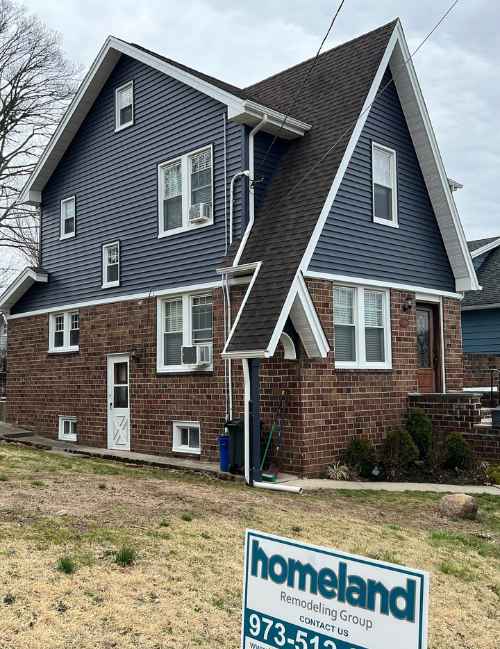The Crucial Overview to the Different Sorts Of Home Siding and Their Distinct Advantages
In the realm of home enhancement, picking the best exterior siding is an important choice that affects both visual allure and functional performance. With so lots of alternatives to take into consideration, which house siding material really stands out for your specific job?
Timber Exterior Siding
Timber exterior siding, a prominent option for property exteriors, provides a timeless aesthetic that incorporates natural charm with structural stability. This house siding material is offered in various designs, including clapboard, roof shingles, and board-and-batten, allowing house owners to personalize their façade to match their design preferences. Wood house siding is normally crafted from sturdy types such as cedar, redwood, or yearn, which are understood for their strength and ability to stand up to environmental stress factors.
One of the key advantages of wood house siding is its exceptional insulation residential or commercial properties, which can add to energy effectiveness and reduced home heating prices. Furthermore, wood house siding is biodegradable, making it an eco-friendly choice when sourced sustainably. Regular upkeep, consisting of paint or staining, can extend its life expectancy and improve its look, enabling property owners to preserve the all-natural charm of the timber.
However, possible downsides consist of sensitivity to pests, rot, and climate damage, requiring ample treatment and maintenance - morris siding contractor. Regardless of these problems, when correctly looked after, timber siding can provide a sturdy and beautiful solution that improves the character of a home while using a warm, inviting atmosphere

Vinyl House Siding
Plastic house siding has actually arised as a leading selection for house owners seeking a low-maintenance exterior choice that integrates longevity and price. This flexible material is crafted from polyvinyl chloride (PVC), making it immune to different climate condition, including wetness and UV rays. Because of this, vinyl siding does not warp, rot, or discolor, making certain durable aesthetic charm.
Among the main benefits of vinyl siding is its extensive variety of shades and designs, allowing property owners to accomplish the wanted appearance for their home without the demand for constant repainting. In addition, plastic house siding is simple to mount, which can significantly reduce labor costs during construction or restoration projects.
Vinyl exterior siding also adds to energy performance. Several choices feature insulation support, which enhances thermal performance, aiding to preserve comfy indoor temperatures and possibly reducing power expenses. Moreover, its smooth surface area promotes simple cleansing, calling for only periodic washing with a yard pipe to get rid of dirt and debris.
Fiber Concrete Siding
Fiber cement house siding has gotten traction amongst homeowners and building contractors alike as a result of its exceptional mix of longevity and aesthetic convenience. Composed of a combination of sand, cellulose, and concrete fibers, this siding choice is engineered to endure severe weather problems, consisting of high winds, heavy rainfall, and temperature level variations, making it a resilient option for residential outsides.

One of a fantastic read the primary benefits of fiber cement siding is its resistance to pests, such as termites, and its non-combustible nature, offering enhanced fire safety. morris siding contractor. Furthermore, it is offered in a vast variety of shades, styles, and textures, allowing house owners to accomplish their wanted aesthetic without compromising efficiency
Another benefit is its reduced maintenance requirements; fiber cement siding typically requires painting or discoloration every 5-10 years, which is much less frequent than various other materials. Its durability adds to a lower total price of ownership, as it minimizes the demand for frequent repair work or replacements.
Eventually, fiber concrete house siding stands for an excellent financial investment for those looking for a resistant, eye-catching, and versatile outside alternative, incorporating both kind and feature to boost the home's aesthetic allure.
Steel House Siding
The attraction of steel house siding hinges on its robust sturdiness and contemporary aesthetic appeal, making it a popular selection for contemporary architecture. Available in products such as light weight aluminum and steel, metal exterior siding provides a range of finishes and shades, enabling homeowners to attain a tailored look that enhances their style vision.
Power performance is another significant advantage, as numerous metal exterior siding products are developed with insulation choices that assist control indoor temperature levels. This can result in decreased energy costs in time. Additionally, metal siding is often recyclable, making it an eco-friendly choice for sustainability-minded homeowners.
The installment procedure for metal exterior siding can be relatively straightforward, leading to a quicker turn-around time for building projects. Overall, metal house siding integrates performance and design, making it a useful option for those looking for a long-lasting and visually appealing outside surface.
Brick and Rock Exterior Siding
Brick and rock exterior siding stands apart as a classic choice that improves the visual appeal of any type of home. Understood for their longevity and reduced upkeep, these products offer a phenomenal return on investment while raising the building's curb allure. Readily available in various colors, textures, and patterns, block and stone can be tailored to match diverse building styles, from traditional to modern-day.
One of the primary benefits of block and rock home siding is their power effectiveness. Both products possess natural protecting buildings that help regulate indoor temperature levels, possibly reducing cooling and heating prices. In addition, they provide remarkable fire resistance contrasted to various other home siding alternatives, adding to enhanced security.
One more advantage is their long life. Block and rock can last for years, often needing very little maintenance beyond occasional cleaning. Unlike wood home siding, they are unsusceptible bugs and rot, ensuring a long-lasting exterior that withstands the elements.
Conclusion
In summary, the selection of siding substantially influences a home's visual charm, power effectiveness, and maintenance requirements. Each sort of siding-- whether timber, plastic, fiber steel, cement, or brick and stone-- supplies one-of-a-kind advantages tailored to various homeowner choices and ecological conditions. Understanding these options enables informed choices that improve both the toughness and aesthetic charm imp source of residential outsides. Eventually, picking the ideal exterior siding is vital for achieving an equilibrium between functionality and layout in domestic design.
One of the primary benefits of timber exterior siding is its superb insulation buildings, which can add to energy performance and reduced home heating prices. Additionally, timber home siding is biodegradable, making it an eco pleasant alternative when sourced sustainably.One of the primary advantages of metal home siding is its resistance to different ecological elements.Energy effectiveness is an additional considerable benefit, as many metal exterior siding items are created with insulation alternatives that help regulate interior temperatures. Each kind of home siding-- whether wood, vinyl, fiber brick, cement, or metal and stone-- provides special advantages customized to numerous homeowner preferences and environmental problems.
 Barret Oliver Then & Now!
Barret Oliver Then & Now! Sydney Simpson Then & Now!
Sydney Simpson Then & Now! Lucy Lawless Then & Now!
Lucy Lawless Then & Now! Andrew McCarthy Then & Now!
Andrew McCarthy Then & Now! Catherine Bach Then & Now!
Catherine Bach Then & Now!